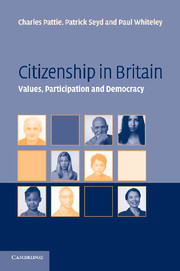Book contents
6 - Testing Rival Theories of Citizenship
Published online by Cambridge University Press: 22 September 2009
Summary
Introduction
In the previous chapter we examined alternative theories of citizenship, defining this in terms of both attitudes and behaviour. In this chapter we focus on testing these theories to see which one gives the most plausible account of citizenship using the empirical evidence from the Citizen Audit. The analysis in the chapter begins by translating the five rival theories discussed in chapter 5 into testable models, so that we can then determine which model or combination of models provides the best explanation of attitudes and behaviour in relation to citizenship. The aim is not merely to identify the best model, but to draw conclusions about the relevance of structural and choice theories as explanations of citizenship in contemporary Britain. The identification of the best model will show that choice theories are particularly important in explaining citizenship. We begin by specifying the alternative models of citizenship in a form that can be estimated from the survey data. The analysis concludes with a discussion of the findings and their relevance to debates about the nature of citizenship in contemporary Britain.
Modelling citizenship in contemporary Britain
The examination of theories of citizenship in chapter 5 began by examining choice theories and this was followed by a discussion of structural theories. We repeat this sequence in the present chapter, by examining the two choice models first and subsequently the three structural models.
- Type
- Chapter
- Information
- Citizenship in BritainValues, Participation and Democracy, pp. 152 - 186Publisher: Cambridge University PressPrint publication year: 2004



